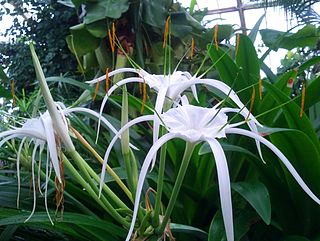
Crithmum is a monospecific genus of flowering plant in the carrot family Apiaceae, with the sole species Crithmum maritimum, known as rock samphire, sea fennel or samphire. The name "samphire" is also used for several other unrelated succulent halophyte species of coastal plant.

Eryngium maritimum, the sea holly or sea eryngo, or sea eryngium, is a perennial species of flowering plant in the family Apiaceae and native to most European coastlines. It resembles a thistle in appearance because of its burr-shaped inflorescences. Despite its common name, it is not a true holly but an umbellifer.

Tripleurospermum inodorum, common names scentless false mayweed, scentless mayweed, scentless chamomile, and Baldr's brow, is the type species of Tripleurospermum. This plant is native to Eurasia, and introduced to North America, where it is commonly found in fields, fallow land and gardens.

Hymenocallis (US) or (UK) is a genus of flowering plants in the amaryllis family native to the Americas.

Pancratium is a genus of African and Eurasian perennial, herbaceous and bulbous plants in the Amaryllis family, subfamily Amaryllidoideae

Pancratium maritimum, or sea daffodil, is a species of bulbous plant native to the Canary Islands and both sides of the Mediterranean region and Black Sea from Portugal, Morocco and the Balearic Islands east to Greece, Turkey, Syria, Israel and the Caucasus. In the parts of its range on the south Bulgarian and north Turkish and Georgian coasts of Black Sea. It is also naturalized in southern California, Bermuda and the Azores.

Chloropyron maritimum is a rare species of flowering plant in the family Orobanchaceae native to western North America. It is known by the common names saltmarsh bird's beak and Point Reyes bird's beak, depending on the specific subspecies.

Tripleurospermum maritimum is a species of flowering plant in the aster family commonly known as false mayweed or sea mayweed. It is found in many coastal areas of Northern Europe, including Scandinavia and Iceland, often growing in sand or amongst beach pebbles.

Lilium maritimum is a species of lily known by the common name coast lily. It is endemic to California, where it is known only from the coastline north of San Francisco. It formerly occurred south of San Francisco, but these occurrences have all been extirpated. The species is now restricted to the North Coast from Marin County to Del Norte County, and is most common in Mendocino County. It grows in the California coastal prairie habitat, coniferous forests, and bogs amongst Drosera species.
E. maritimum may refer to:

Neobisiidae is a family of pseudoscorpions distributed throughout Africa, the Americas and Eurasia and consist of 748 species in 34 genera. Some species live in caves while some are surface-dwelling.

Hans Henderickx (1961–2016) was a Belgian entomologist specializing in Invertebrates born in Mol, Belgium.
Tenacibaculum is a Gram-negative and motile bacterial genus from the family of Flavobacteriaceae.

Neobisium is a genus of pseudoscorpions in the family Neobisiidae.
Neobisium beroni is a species of pseudoscorpions in the Neobisiidae family. It has only been found in Bulgaria. Its type locality is cave Svinskata peshtera, Lakatnik, Iskur River gorge, Sofiya, Bulgaria.
Neobisium noricum is a species of pseudoscorpions in the Neobisiidae family. It has only been found in Austria, and once in Hungary. The type locality is Hohentauern in Styria, Austria.

Sesuvium maritimum is an annual herbaceous plant native to southeastern North America in the family Aizoaceae. This species is commonly known as the annual or slender sea purslane or Puerto Rico Sea-purslane. It can be found on sandy beaches, salt marshes, or other coastal regions.











